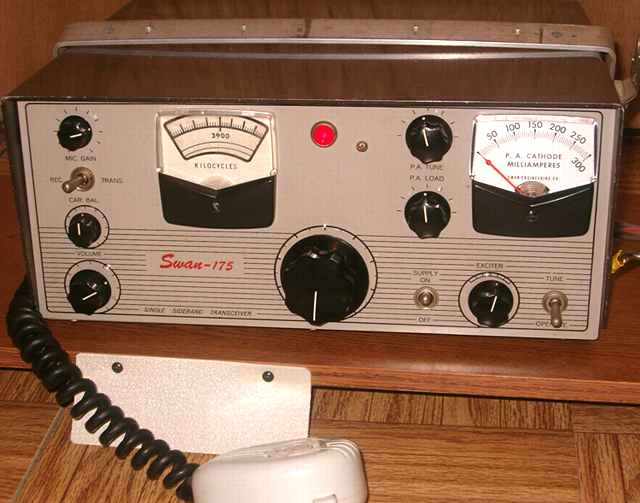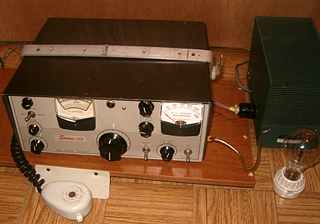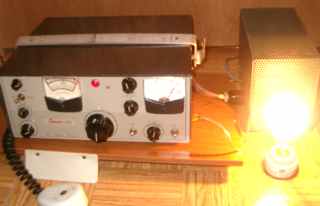


Swan in tune position to 250 mA load (for only a very few seconds) really makes a 135 watt dummy load bulb shine.
The Swan 175 is the 80 meter version of a series of three amateur band SSB transceivers known as "mono-banders" because of their single band design. RF input is rated at 240 watts P.E.P. using a 6DQ5 tube. Other tranceivers in the series are the 120 and the 140 designed for 20 and 40 meters respectively.



AC Power Supply
Like most monobanders, an external power supply is used since the unit could then also be used in mobile applications. The manual for the 175 gives instructions for modifying a Heathkit HP-20 power supply to match the Swan. However, what I had was a Heath HP-23 supply as shown above. I checked into the specs of both the HP-20 and the HP-23 series to determine if the Swan could handle the apparent increased high voltage. The HP-20 is rated at 600 volts and the HP-23 is rated at 820 volts. The power transformer of the HP-20 puts out 260 V AC while the HP-23 puts out 268 according to their schematics, a difference of only 8 volts. Both use near identical voltage doubling circuits. Why was the HP-23 showing an extra 220 volts more than the HP-20?
After comparing the specs, I determined that the HP-20 was rated at 600 volts under load and the HP-23 spec for high voltage was rated at 820 volts at no-load. According to its manual, the HP-23 high voltage drops to 700 with a 250 mA load. Since the HP-23 is used with Heath monobanders, there was no reason not to use it with the Swan. A quick comparison of the output tubes specs of the Heath HW-12 and 12A with the Swan's 6DQ5 showed that the 6DQ5 was more than capable of handling the high voltage. The HP-23 high voltage was also well within the specifications called for in the Swan manual.
Repairs/ Modifications
I cleaned all the controls and connectors with contact cleaner. Early checks indicated that two of the toggle switches were open. The contact cleaner cured that problem.
The Swan manual calls for modifying the Heathkit HP-20 power supply to provide the 12 volts DC required for the transceive relay and adding a 4700 ohm resistor to reduce the bias voltage from -130 to the needed -90 volts.
Instead of modifying the HP-23 which I use for other projects, I opted to modify the Swan in as simple and unobtrusive manner as possible. The terminal strip for one of the voltage regulator resistors had several unused lugs on which I mounted a diode and electrolytic for the relay supply. I also mounted a 7812 three-terminal regulator under an existing mounting bolt to keep the relay voltage at 12. A couple of reverse-bias protection diodes were also added, one across the 7812 and one for the relay coil. The added 4700 ohm resistor for lowering the bias voltage was mounted using unused lugs 4 and 6 on the socket of the voltage regulator tube. Both mods are easily reversible. A page of notes with mod schematics was added to the manual.
The microphone used with the rig is the Turner 350 high impedance ceramic. I had to repair its coil cord and clean its push-to-talk switch contacts.
Performance
I noticed a bit of hum at low audio output settings that was not reducible by the volume control. Will check to see if more filtering is required in the 275 volt line or if heater-cathode leakage in the 6V6 is the culprit.
I found the overall performance of this rig to be surprisingly good and the quality of the layout and wiring equally good, a fine 80 meter rig.
The schematic and manual for the Swan 100 series monobanders as well as manuals for many other Swan models can be found at this link.
Thanks go to John NC8V for giving this Swan 175 a good home.
The Lafayette Explor-Air Mark V Receiver was the previous item on the bench.